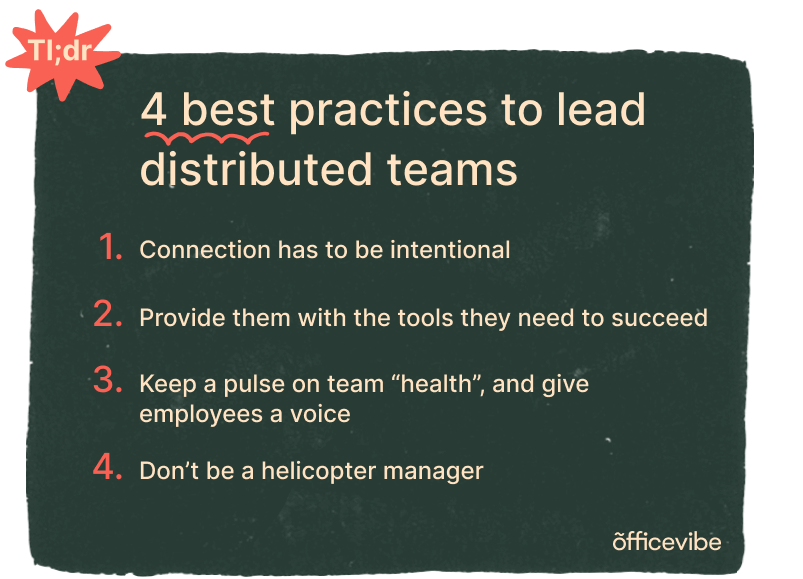If you’re leading a distributed team, you may have realized over the last two or so years that there’s so much more to it than downloading Zoom and sauntering into the virtual space. Much like thought goes into the architecture of office spaces to enhance team collaboration and productivity, the same thought needs to go into how we function in a digital reality. Moving beyond how we arrange desks and what motivational words we hang on the walls, leaders of distributed teams need to consider how to rearrange work processes, rituals for connecting, and more.
In this article, you’ll learn four best practices to live by that set the foundation for successful team performance.
From flawed to flawless: 5 steps to leading distributed teams

4 best practices to lead a distributed team:
Why it’s important to have structure on a distributed team
A distributed team without structure is a ticking time bomb; set up to fail, even implode. Think of it this way, a company and the teams that form them are like microcosms of our society at large. The reason why we are able to function well as a society is because there are a set of common norms in place - a structure. Traffic lights to guide our movements and laws to help guide a set of expected behaviors. Remote teams, most especially those working from different cities and time zones, need this same sort of guidance to overcome their challenges. A set of “rules and tools” to harmonize processes, work methods, and expectations.
4 best practices to lead distributed teams
1. Connection has to be intentional
The remote and distributed workforce models are widely appreciated by modern workers, but not without certain pitfalls. When the pandemic hit, our ability to socialize and connect with people took a hit, and for many this was detrimental. Harvard Business Review discusses the rise in loneliness, citing that it “brings health problems, reduced productivity, turnover, and burnout.” Teams whose sense of connection is broken risk falling into a spell of underperformance. Why? Relationships, trust, and the ability to communicate comfortably with one another make up the infrastructure of successful teams.
Make connections happen:
Managers, while your remote team cannot physically be together during lunch hour, be sure to set some virtual lunches on your team’s calendar. These casual moments of connection we once had at the office were essential in creating positive team dynamics, so don’t let them fall flat. This is especially true as you bring in new hires who have not had the chance to meet anyone in person.
2. Provide them with the tools they need to succeed
Remote teams require the right tools to function seamlessly. It’s your job to help your remote team move into a virtual space, and ensure they use the most appropriate tools for their needs.
Choosing the right set of distributed work tools typically starts at the organizational level to ensure that all teams across the company are working harmoniously. However, it’s important to ask your team what they need, too. Be open to hearing about what types of software they might need to be more productive, efficient, and even creative from home. And of course, be prepared to pitch them to your own manager.
Tools to consider
1. Communication tools
There are many shapes and forms communication can take on distributed teams. Think about daily written communication tools like Slack, email tools like Outlook, video communication tools like Microsoft Teams and Zoom, and hybrid work tools like Officevibe.

Officevibe allows distributed team managers to keep communication lines open at all times, heightening the employee voice. Offering a feedback platform for employees to share both their hopes and challenges is a game-changer for employee engagement. Try Officevibe for free.
2. Collaboration tools
No more whiteboards and post-its to get a good brainstorm going. You’ll need to find new ways for your distributed team to collaborate. Consider a tool like Miro to host successful collaboration sessions or a project management tool like Asana to keep track of collaboration on your team. Our team has thrived using it!
3. Retrospective tools
Now more than ever, teams need to look back and discuss how things have been going, together. These moments of reflection are essential for teams to have honest discussions with one another about team dynamics, or even work processes.
Retrospectives are team meetings where managers and employees sit together and reflect on the work done during a certain period (usually since the last retrospective). These team meetings allow employees to be agile and iterate, so they can constantly improve.
3. Keep a pulse on team “health”, and give employees a voice
Working in person allowed leaders to have visual signals as to how their people were feeling, but when working remotely, it’s not as easy to gauge. If managers begin to lose track of how their people are doing, performance can unravel quickly, and turnover might spike.
The best tip for managers of distributed teams is to remember that out of sight should not mean out of mind. Find ways to check in with your people often. Remember to give them a voice constantly. This means asking them to share opinions and voice ideas, as well as providing them with the right moments and tools to do it.
Employees are the most “vested stakeholders” you have. Unlike customers (who can switch suppliers) or investors (who can sell their stock), employees vote with their lives to work for you. They put their family earnings, time, and personal energy into your company. So when they have problems or good ideas, you really have to listen. -
How managers can check in with their distributed teams
Hold frequent 1-on-1s: We suggest weekly virtual 1-on-1s with each team member to check in both as people, and workers. Take the time to ask how people are doing, what blockers they have, and how you can help. Even 30 minutes a week reminds employees that you care. It’s also an essential time to align on expectations and make sure they’re set up to achieve their goals.
Use a pulse survey tool for distributed teams: Officevibe - our Pulse Survey and feedback tool - provinces managers with a weekly report on their team’s health across 10 levels of employee engagement. It automates all the important questions you want to ask but might not have time to, giving remote team members a continuous voice.

4. Don’t be a helicopter manager
Managers with newly remote or distributed teams need to be mindful of micromanaging tendencies that might pop up. You went from having a full visual of where people were and what they were doing every day to having a smaller lens on what people are up to.
Wait. Before you check in one too many times, remember that you hired your people for a reason and that remote employees expect trust and autonomy from their leaders.
How to avoid micromanaging
First, be honest with your team. You’re all going through a change together. If you’re unsure of whether you’re checking in too much, let them know that you’re working on finding the balance, and ask them to tell you if they’re feeling “smothered” or untrusted. This vulnerability is helpful in creating more authentic relationships with your distributed team members.
In addition, here are some reflection questions you might want to ask yourself before you send that message or make that call.
Reflection questions to avoid micromanaging:
1. Do I need to know this now? Or, can it wait until our upcoming 1-on-1?
2. Did this team member give me a reason to assume they are not on top of their tasks? Or is this my own need for control?
3. Do I feel pressured by my own manager for constant updates? If so, maybe the talk you need to have is with them, not with your team.
4. Would contacting my employee right now distract them from the work they’re getting done?
How can leaders thrive in a distributed environment?
We’ve covered how you can help remote employees thrive, but what about you? You play a crucial role in leading a healthy, high-functioning dispersed team, but a team is only as strong as the leader who guides them. So, let’s take a minute to make sure you’re well set up as well. Here’s some advice from Officevibe’s own managers on managing distributed teams.
- Ask your manager for the tools YOU need to perform. Don’t hesitate to voice what’s needed to be successful in a distributed reality (just be sure to make a case for its impact).
- If your manager is not scheduling you for 1-on-1s, be sure to ask for them. You need an outlet as much as your employees, and expectations around your success is critical to the success of your entire team.
- Find a mentor in your company who has worked in a distributed workplace before so you can bounce ideas. If that’s not the case, take the time to connect with other managers to share best practices and learnings around navigating this new reality.
- If you encourage work-life balance on your remote team, be sure to prioritize it for yourself too. Lead by example.

Equip HR and managers with tools to engage, recognize, and drive performance.




